SDG14
Life Below Water
SDG14
Life Below Water
Supporting aquatic ecosystems through education
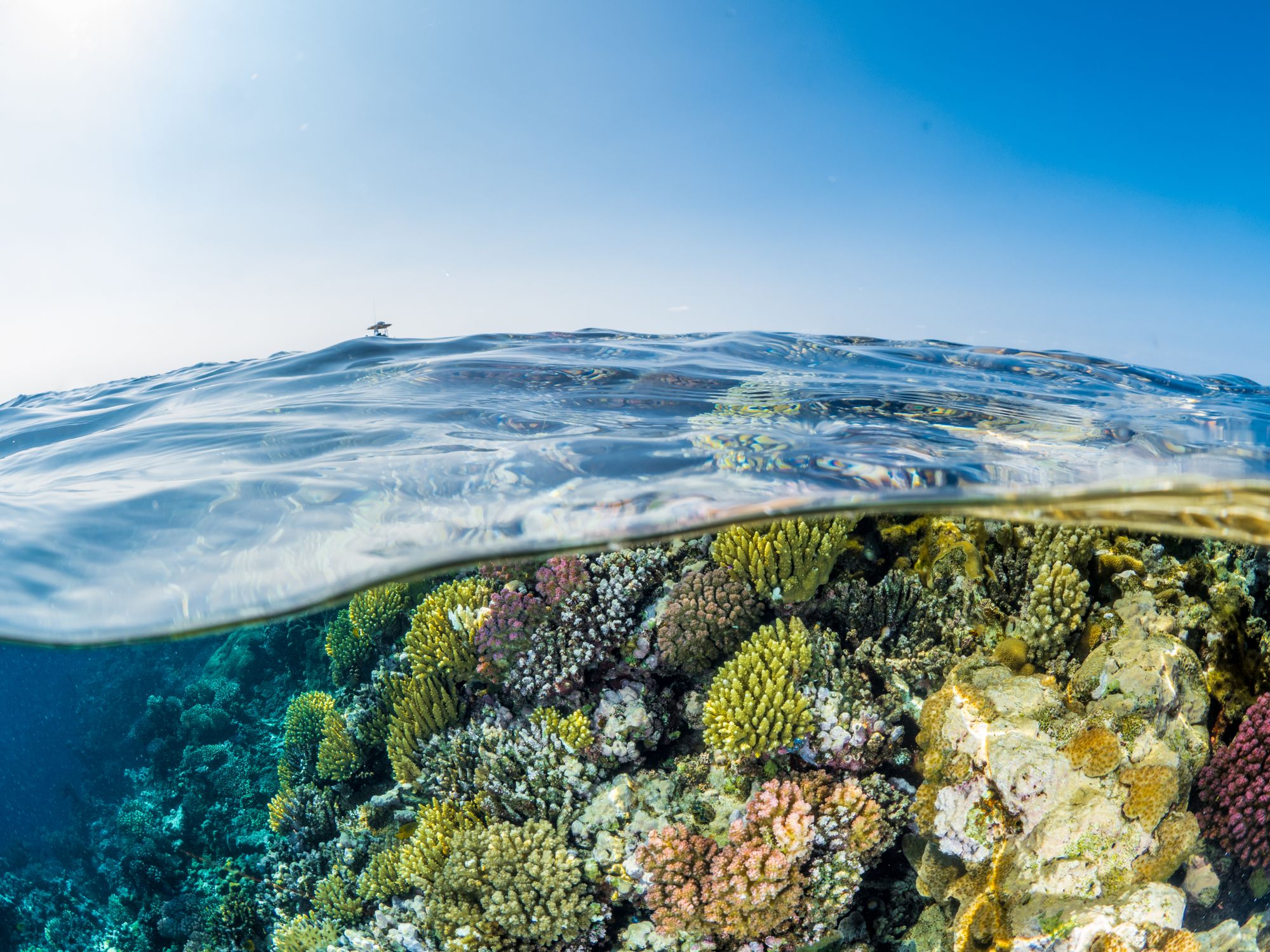
Red Sea coral reef. Photo: M. Bennett - Smith
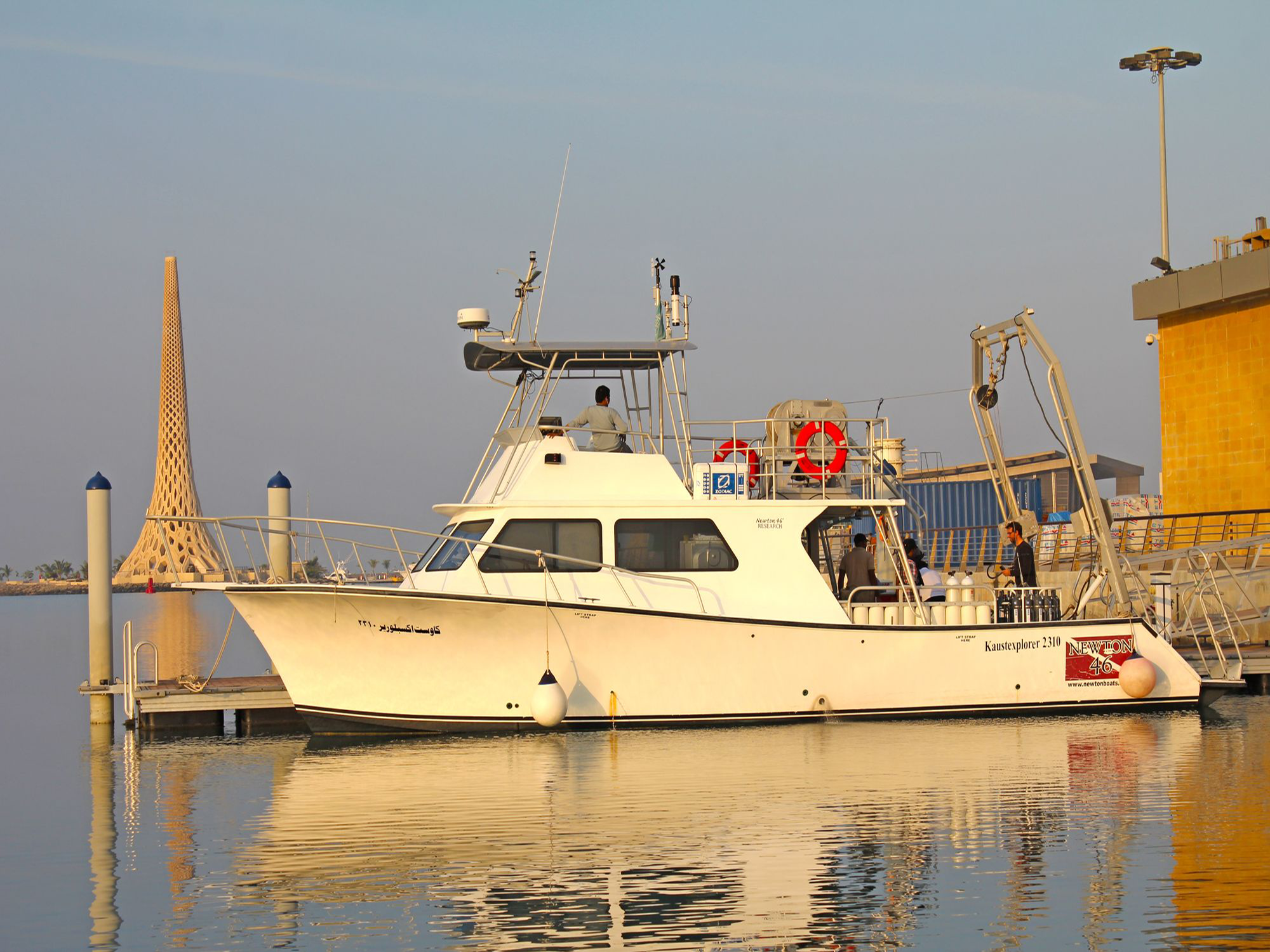
Research Dive Boat, the KAUST Explorer
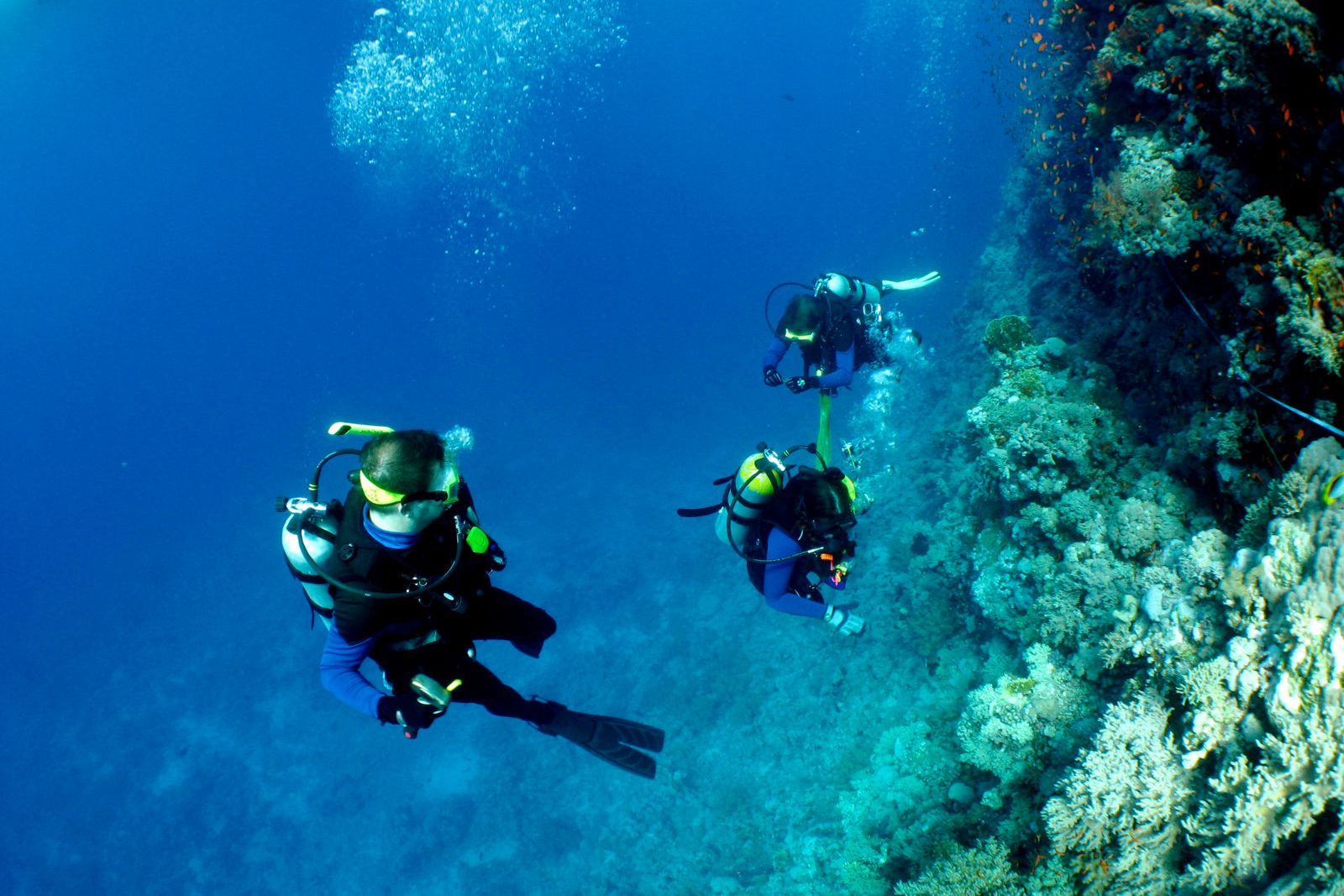
KAUST researchers diving in the Red Sea
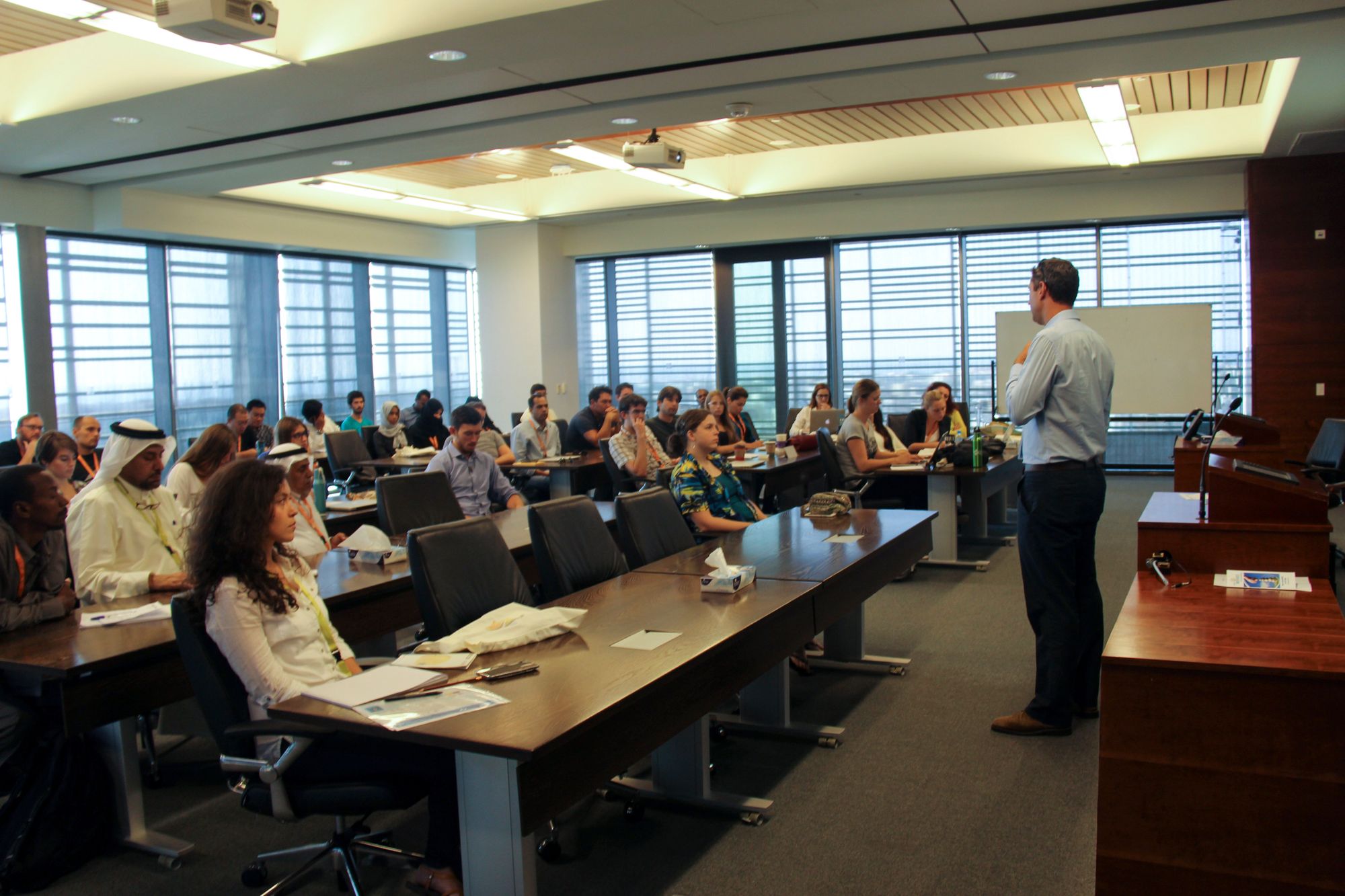
Prof. Michael Berumen, Director of the Red Sea Research Center, giving a Lecture
KAUST has a track record of excellence in studying and protecting the marine environment. One of the most prominent research bodies working towards sustainable oceans is KAUST's Red Sea Research Center (RSRC). Offering a Marine Science Program with extensive Master and Doctoral level courses, the RSRC faculty offers a diverse curriculum in marine ecology, fisheries, genomics, microbiology, oceanography, and conservation.
Students have their marine research supported by both the RSRC facilities and the Coastal Marine Resources Core Labs facilities, which support all marine operations by providing research vessels, wet lab facilities, and several oceanographic instrumentations to support researchers in sea exploration.
Sustainable exploration of fresh-water resources
Reports to THE Impact Ranking indicator 14.2.1
KAUST is located by the shore of the Central Red Sea and, therefore, possesses no natural fresh-water ecosystems in its vicinities. However, as water is one of the main pillars of the university's research and a pivotal resource for Saudi Arabia, KAUST organizes multiple events and activities to address water security.
Several free activities related to freshwater management, some of them targeting the surrounding community, are organized by the Water Desalination and Reuse Center and have the goal of educating the community on the importance of preserving groundwater reservoirs and of exploring more sustainable ways of performing water desalination, the main potable water source of the country.
Either through World Water Day celebrations, community events, or water research awareness campaigns with local and national school students, community members of all ages get involved in activities that convey the global importance of water as a vital resource.
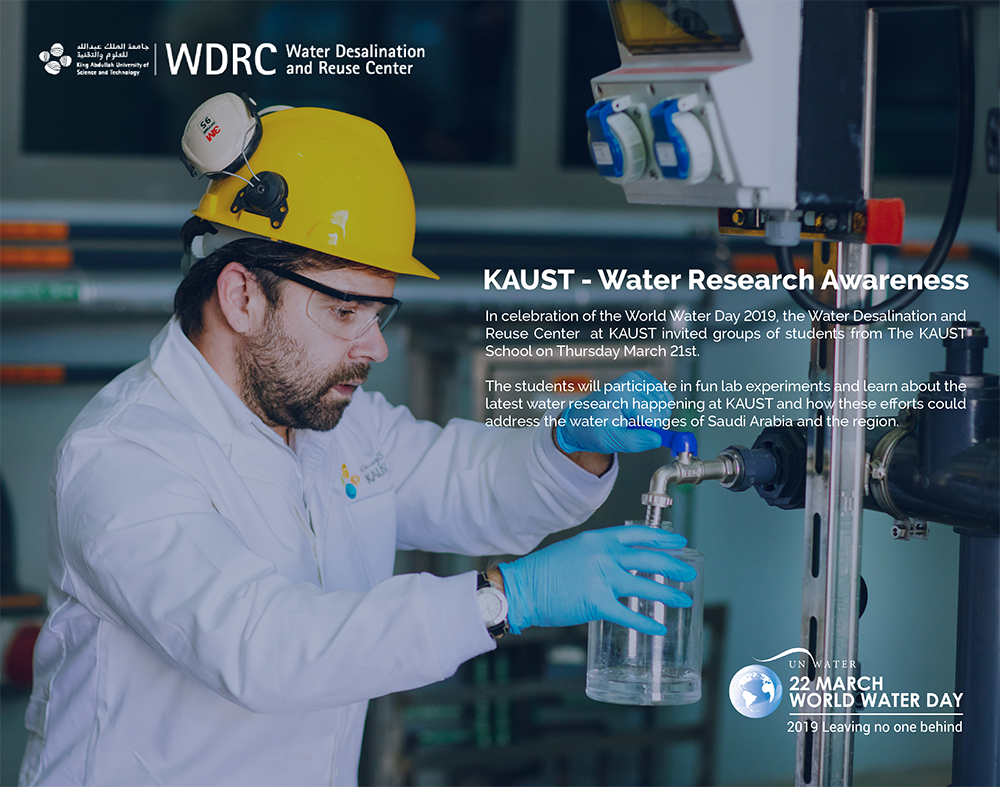
Announcement of a Water Research awareness carried by the WDRC in celebration of the World Water Day (2019)
Sustainable exploration and conservation of marine resources
Reports to THE Impact Ranking indicators 14.2.2, 14.2.3 & 14.3.1
KAUST has been involved in sustainable fishing studies and collaborations over the last decade. Through collaborations with institutional and corporate partners on aquaculture development, KAUST has shared its expertise on how to explore the Kingdom's marine resources while implementing and exploring more sustainable practices.
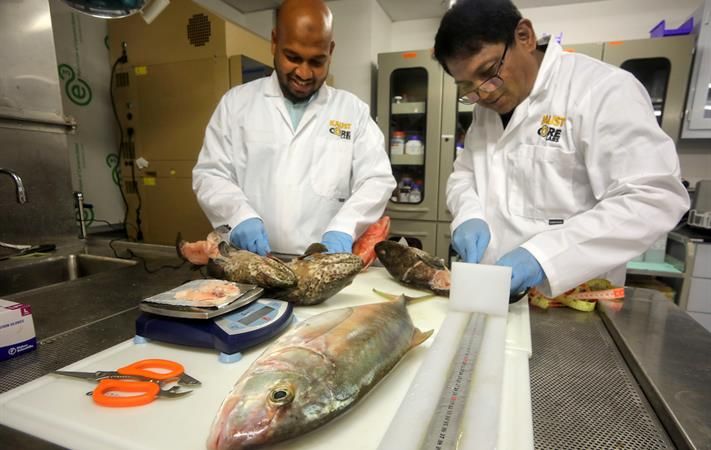
Coastal & Marine Resources Core Lab staff sampling fish for the quality and safety assessment of fishery products project, concluded in 2019. Photo: B.Chew
Of note, in partnership with King Abdulaziz City for Science and Technology (KACST), KAUST has also designed and conducted a comprehensive project to assess the quality and safety of fishery products in the Red Sea and the Arabian Gulf, which concluded in 2019.
As part of local and national outreach campaigns on the importance of the sea, the subject of sustainable fishing and overfishing is routinely addressed and contextualized for the Red Sea. In particular, participants are informed on how to protect large reef fish, and the iconic Whale Shark, found and studied in the Red Sea.
The Health, Safety and Environment (HSE) department has also installed a live, underwater camera at the shore of King Abdullah Monument, at KAUST. The live-streamed video showcases the Red Sea marine life in real-time, 24/7, and presents the community, and anyone in the world, with the amazing preserved biodiversity on KAUST waters. Reef fish, rays, turtles, or octopi have been spotted through the stream, making KAUST's underwater life accessible to anyone.
KAUST Fish KAM Live-Stream
Map of allowed fishing zones at KAUST
HSE has also designated specific fishing zones, in order to support recreational fishing in a sustainable manner. The locations are chosen based on a range of attributes, including, but not limited to, ease of access to water, not fish nursery or designated protected areas, safe conditions, and water quality and depth. This initiative allows anglers to enjoy a relaxing outdoor activity whilst ensuring the marine ecosystem is protected.
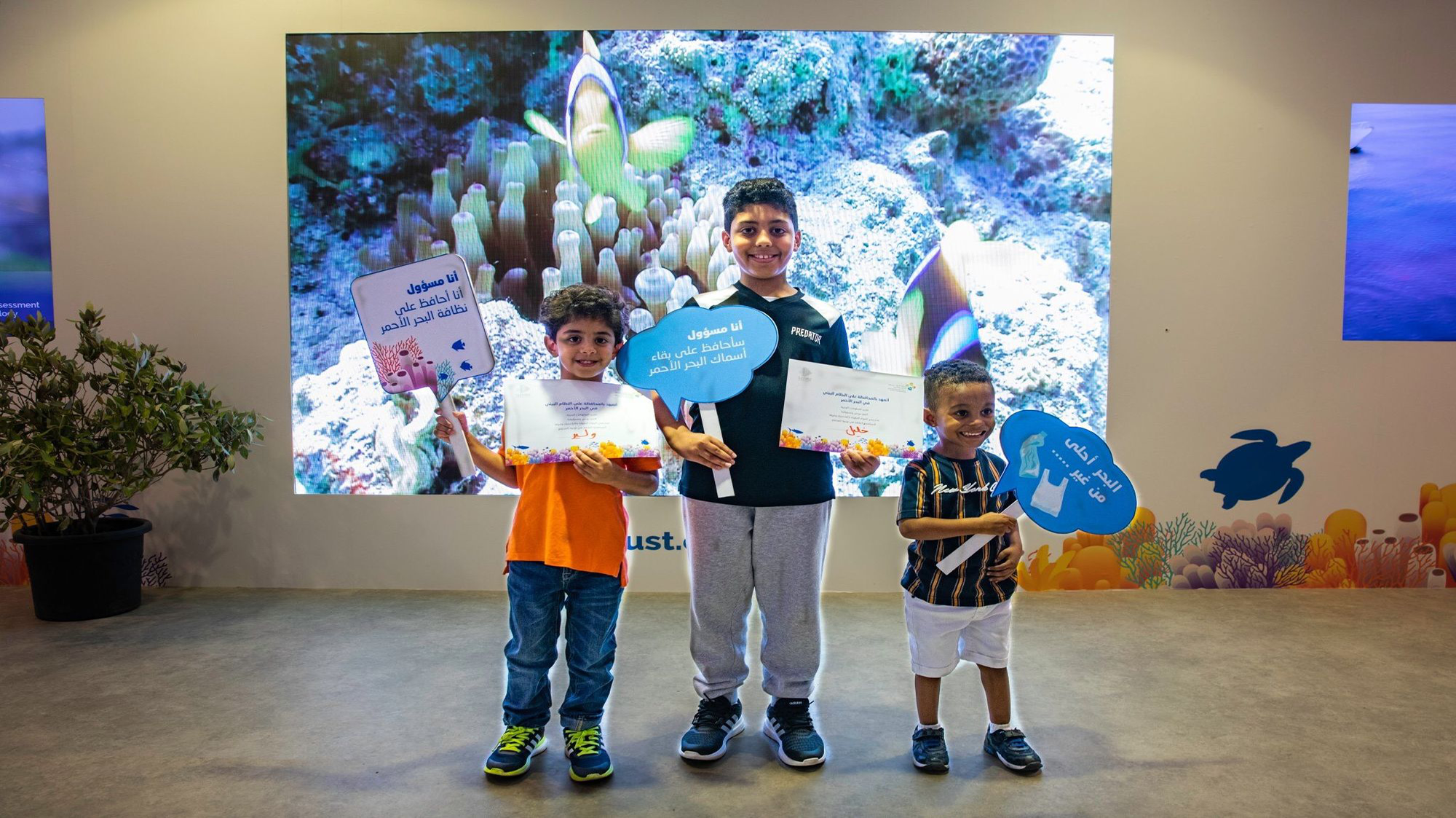
RSRC outreach campaign at The Red Sea Mall in Jeddah (2019). Children signed a pledge to protect the oceans. Photo: H. Bashatah
KAUST exhibit at the Asbar World Forum, featuring the RSRC real size model of a whale shark. RSRC Alumni Dr. Hardestine explains how whale sharks are studied and their importance for eco-tourism
At local schools, KAUST also performs several outreach campaigns to expose children to ocean conservation. Adapted to different ages, scientists showcase their research in accessible language and contextualize their work for young audiences.
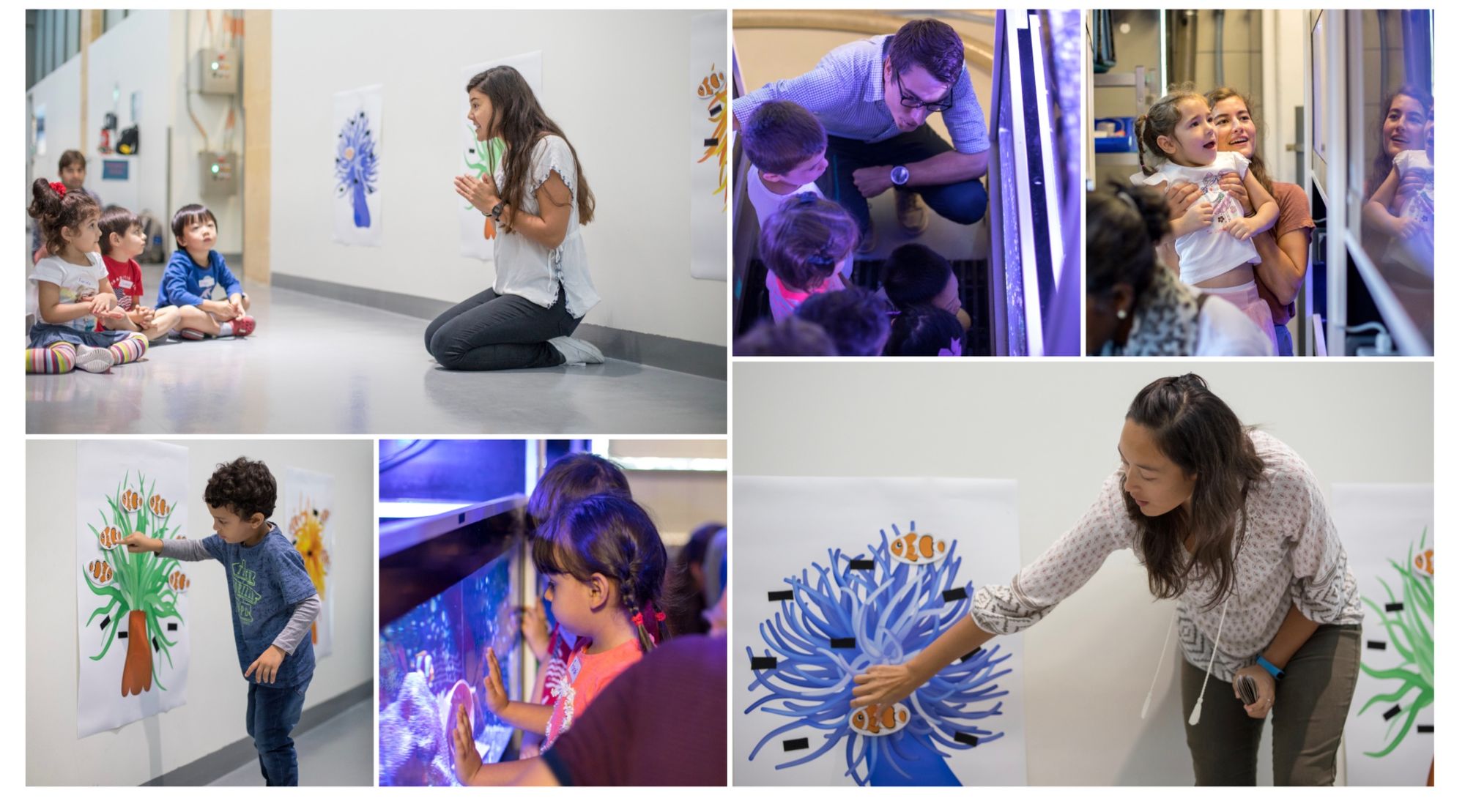
RSRC Reef Ecology Lab in educational outreach activity with K-1 students explaining how baby Red Sea clownfish choose their sea anemones and the importance of not removing reef fish from their environment (2019)
Specific activities such as the Social Responsibility’s Science Summer School, organized by KAUST's Strategic National Advancement (SNA) department, go further in the involvement of older students with research done at KAUST. High school students (selected through SNA's Young Learners' Development Program) have the opportunity to be mentored by graduate students and develop projects that are then presented in open conferences.
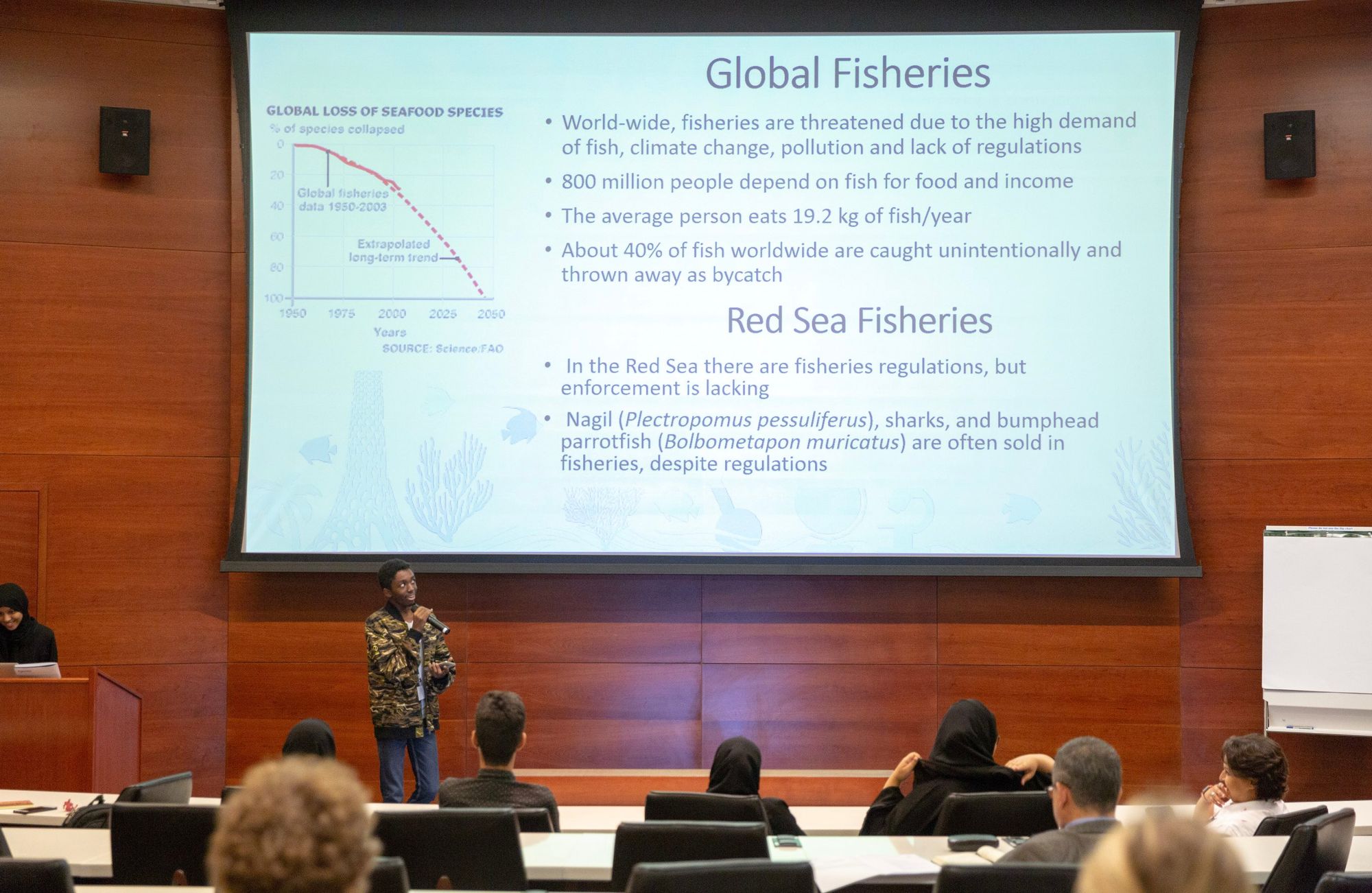
Local high school students from Social presenting their project on local fisheries at the RSRC Open Science Conference
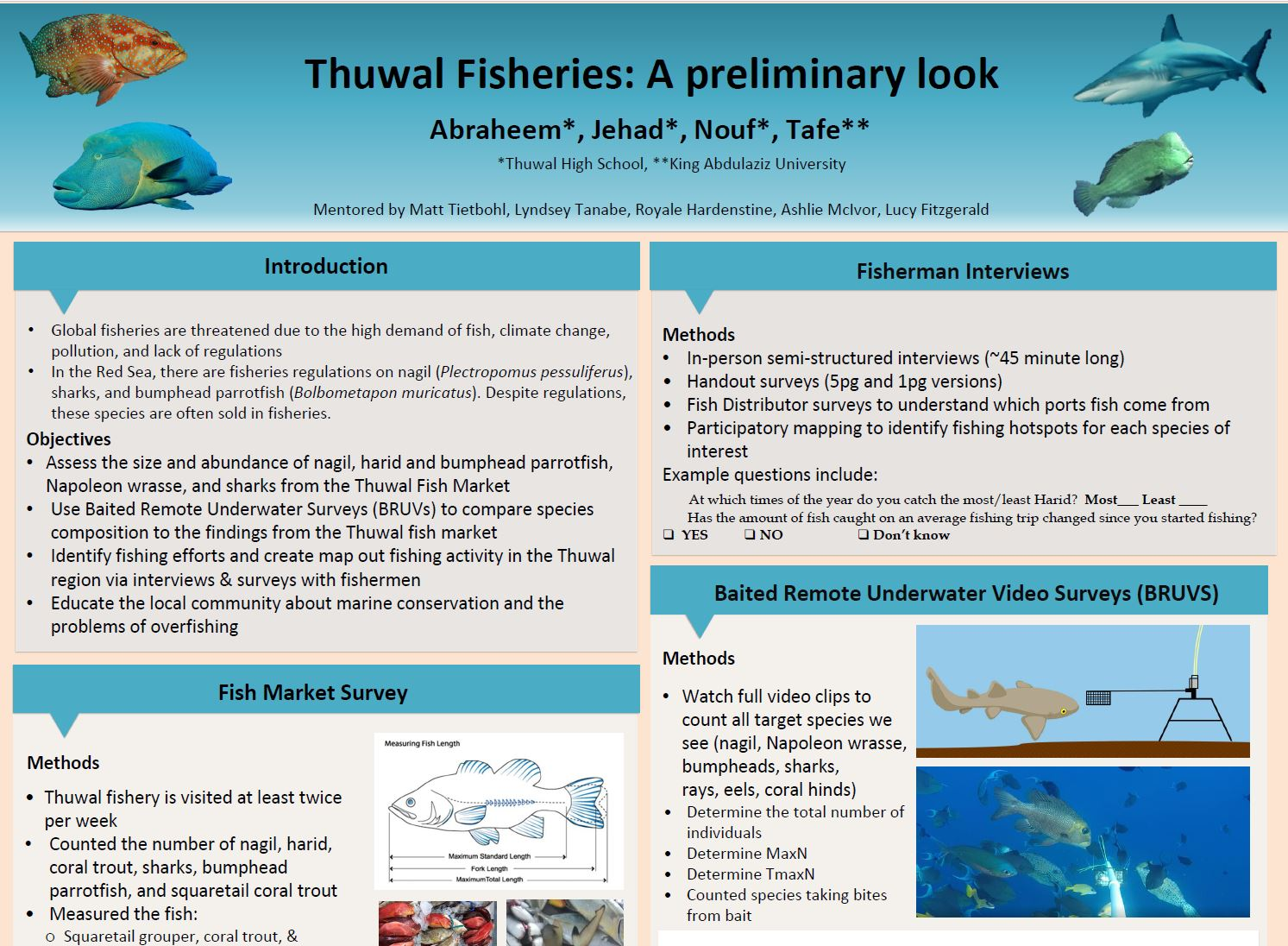
Example of Poster presented by local high school students in the poster session of the RSRC Open Science Conference
Researchers of the Red Sea Research Center also work on fisheries and aquaculture. They routinely share their research in international and community-open local conferences. Key national stakeholders are also invited to engage in research discussions, in order to quickly translate fundamental knowledge to applied industrial solutions.
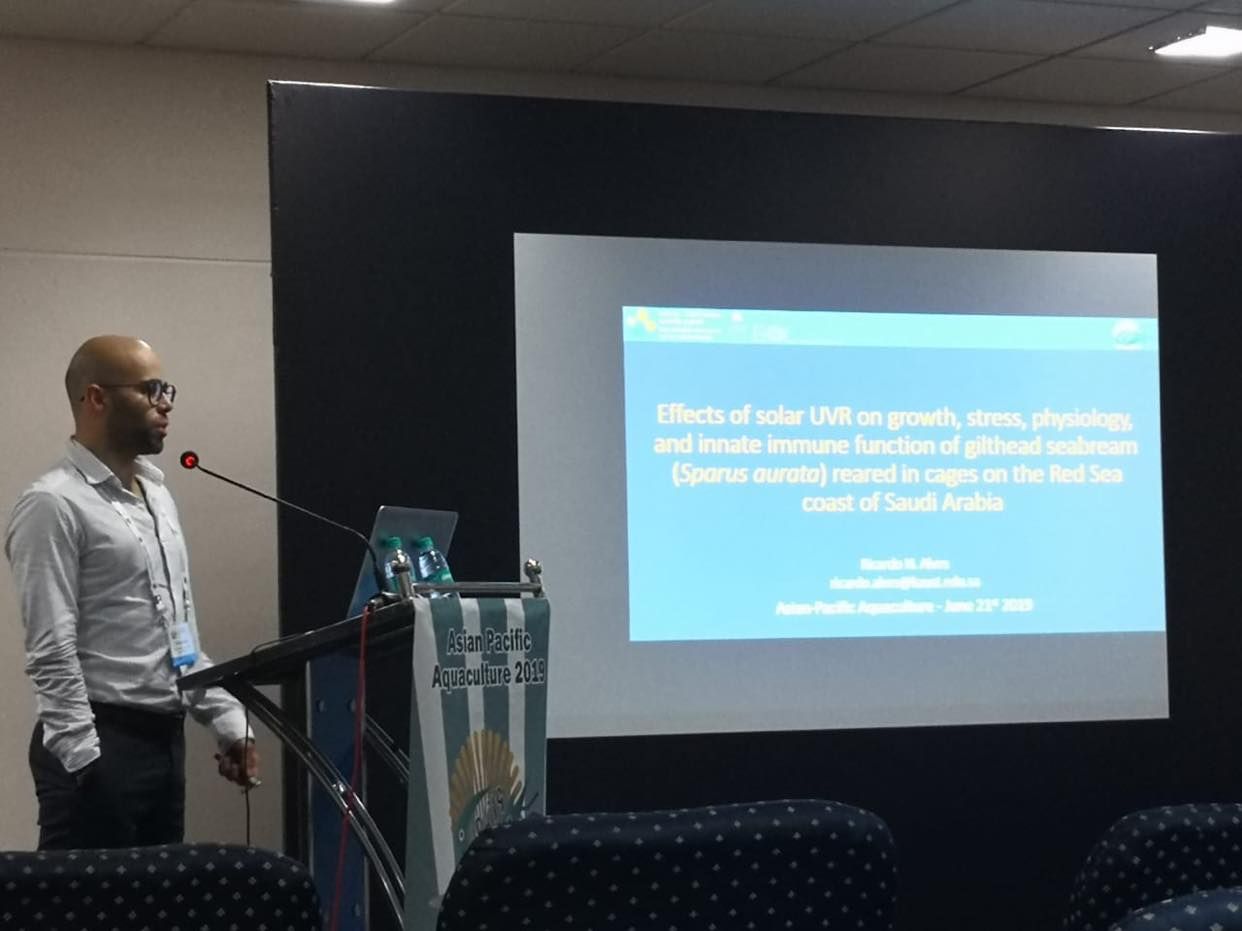
KAUST Researcher presenting work at the Asian-Pacific Aquaculture Meeting (2019)
With the ultimate goal of preserving the oceans and the Red Sea, the RSRC routinely organizes workshops and conferences where international keynote speakers in the field of marine conservation are invited to showcase and discuss their work with students and faculty.
As for the local and global community, KAUST routinely enriches the public with several events and activities that portray the importance of the world's oceans by tackling different subjects within marine sciences in the form of
open talks,
international days' celebrations,
movie screenings,
podcasts,
among others.
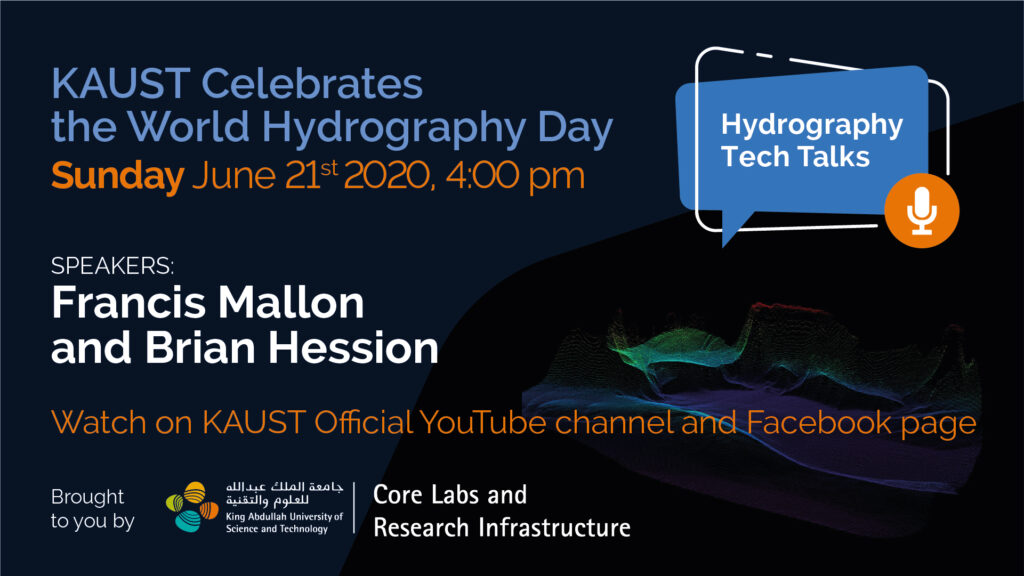
Announcement of KAUST's World Hydrography Day celebration (2020)
KAUST also supports the Kingdom's vision of developing environmentally-conscious tourism. By securing a partnership with The Red Sea Development Company (TRSDC), responsible for one of the world's most ambitious sustainable tourism projects, the university has lent its extensive expertise on the Red Sea. KAUST Distinguished Professor of Marine Science Carlos Duarte is also a member of the TRSDC Global Advisory Board and has been instrumental in advising towards the sustainable development of the project.
The KAUST-TRSDC partnership was further strengthened by the appointment of Dr. Rusty Brainard, the Chief Environmental Sustainability Officer of TRSDC, as Courtesy Professor of Marine Science at KAUST. The appointment aims to facilitate active collaboration between the company and the suite of world-class faculty and students of KAUST, demonstrating the university's efforts in supporting sustainable tourism development and overall eco-tourism.
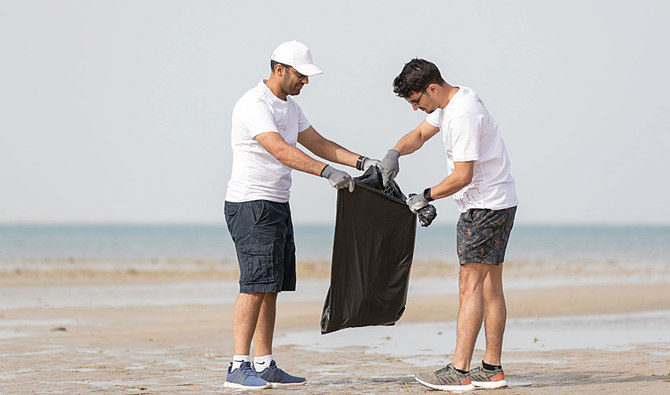
Participants at the Marine Debris Beach Clean Up Program (2019). Photo by TRSDC
KAUST also collaborates with TRSDC in other different educational and awareness initiatives such as the company's Marine Debris Beach Clean Up Program, which aims to eliminate marine debris from the project shores.
Supporting aquatic ecosystems through action
Maintaining ecosystems and their biodiversity
Reports to THE Impact Ranking indicator 14.3.3
Outreach video produced by KAUST covering an international collaborative work that concluded that marine life can still be rebuilt by 2050 if appropriate actions are taken (2020)
KAUST was built with a strong vision of environmental stewardship. The research performed by KAUST scientists reflects the university's commitment to protecting and enhancing its surrounding environment. As stewards of marine life, KAUST scientists are globally recognized for their extensive work on key aquatic ecosystems and have contributed to studies that can support policy creation towards more sustainable oceans, and therefore, a more sustainable climate. KAUST faculty have also organized a conference specifically targeting the future of Red Sea Ecosystems, which involved several experts from academia, industry, and government, with the aim of setting targeted strategies that are sustainable, socioeconomically acceptable, and aligned with the public, academic, industry, and government interests. Finally, during 2019-2020, KAUST has performed extensive research and advocacy work to protect, regenerate and enhance Saudi Arabian marine ecosystems, namely coral reefs, seagrass meadows, and mangrove forests.
Coral Reefs
The protection of coral reefs is of utmost importance for KAUST, both locally and globally. The Red Sea is home to unique coral reef ecosystems that, due to their corals' resilience and plasticity, might hold important answers on how to mitigate coral bleaching and mortality in other reefs across the world.
KAUST researchers have been studying several key topics of great importance to coral conservation, such as their
genetics,
epigenetics,
taxonomy, the
adaptation
strategies employed by them to survive ocean warming, and their importance in
protecting the Saudi Arabian coast.
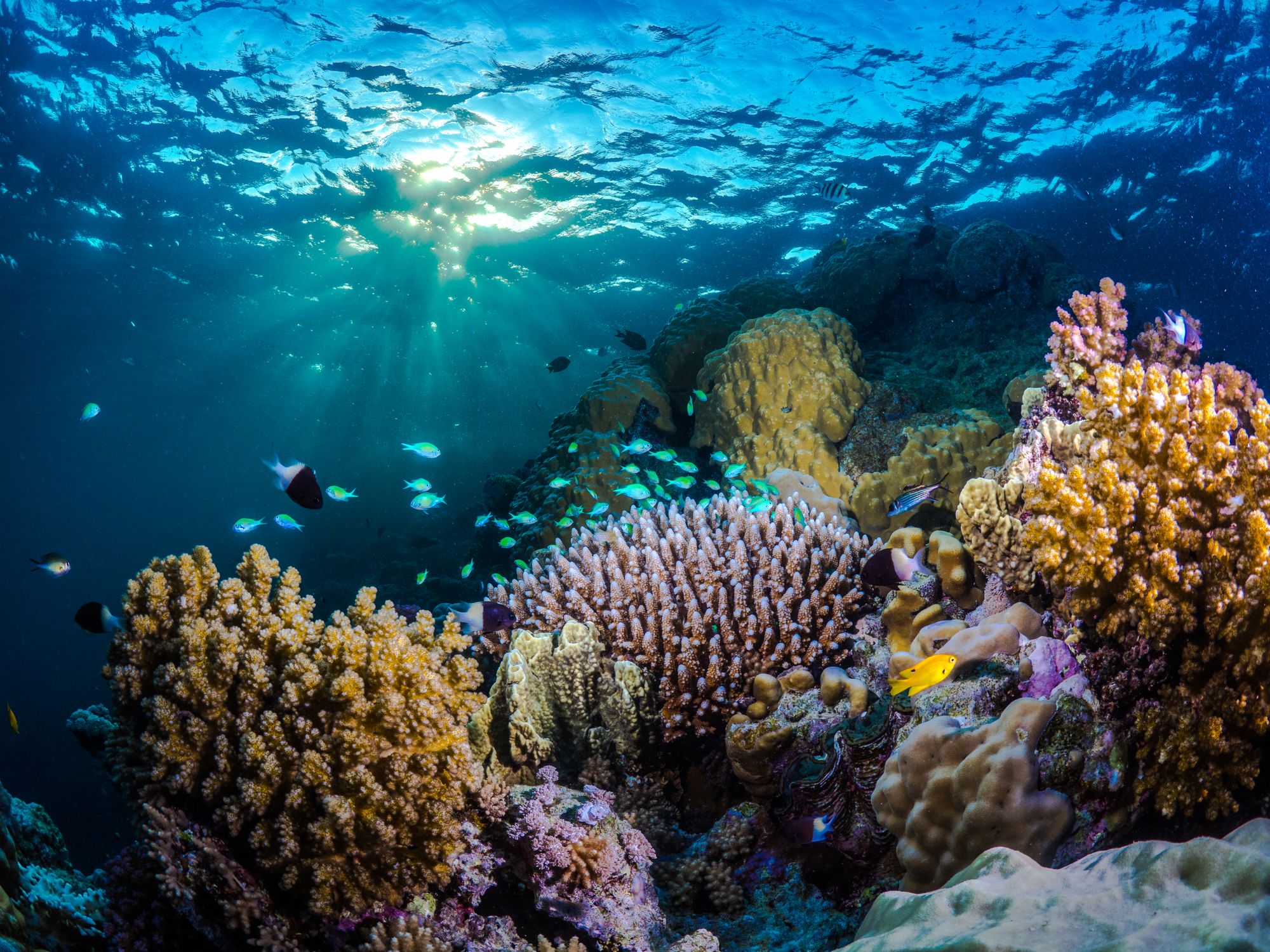
A Red Sea coral reef. Photo: Morgan Bennet-Smith
KAUST has also developed innovative methods to study how corals respond to stressors, from novel approaches to measure how they take up marine pollutants, to predicting bleaching events using remote sensing algorithms. Aiming to develop mitigation strategies and solutions for coral reef degradation, KAUST faculty are also co-chairing international scientific networks such as the Beneficial Microorganisms for Marine Organisms Network (BMMO). The network connects researchers from all over the world and explores the possibility of using microbial therapy to increase coral resistance to disease and reduce coral bleaching and mortality.
In order to raise global awareness on the importance of preserving corals worldwide, KAUST successfully introduced the topic of coral protection at the top of the G20 Agenda. The result of such effort was the establishment of a G20 Coral Reef Protection Initiative. The Global Coral Reef R&D Accelerator Platform was launched at the G20 Summit in 2020, aiming to accelerate international research and development in improving the survival, conservation, resilience, adaptation and restoration of coral reefs. KAUST was appointed the Platform Central Node (PCN) thanks to the cutting-edge infrastructure, expertise, sequencing capabilities, advanced sensor technology, and local coral reefs it can provide to researchers in the field.
Mangroves and Seagrasses
Red and Blue, an outreach video showcasing KAUST's Distinguished Professor Carlos Duarte explaining how mangroves and seagrasses can help mitigate climate change (2020)
Harboring 152 hectares of protected area reserved for nature conservation and research, KAUST has also been securing and enhancing its surrounding mangroves. Being one of the most productive ecosystems in the world, mangroves fulfill several ecological roles. However, they have sparked recent interest due to their potential to be effective carbon sinks, by removing CO2 from the atmosphere and storing it in the sediment, and by being effective calcium carbonate dissolvers.
In fact, mangroves are so efficient as blue carbon sinks, that they are able to bury carbon at a rate 30 times higher than that of boreal, tropical, and temperate forests. For this reason, KAUST researchers have proposed mangrove conservation as an effective blue carbon strategy to mitigate climate change.
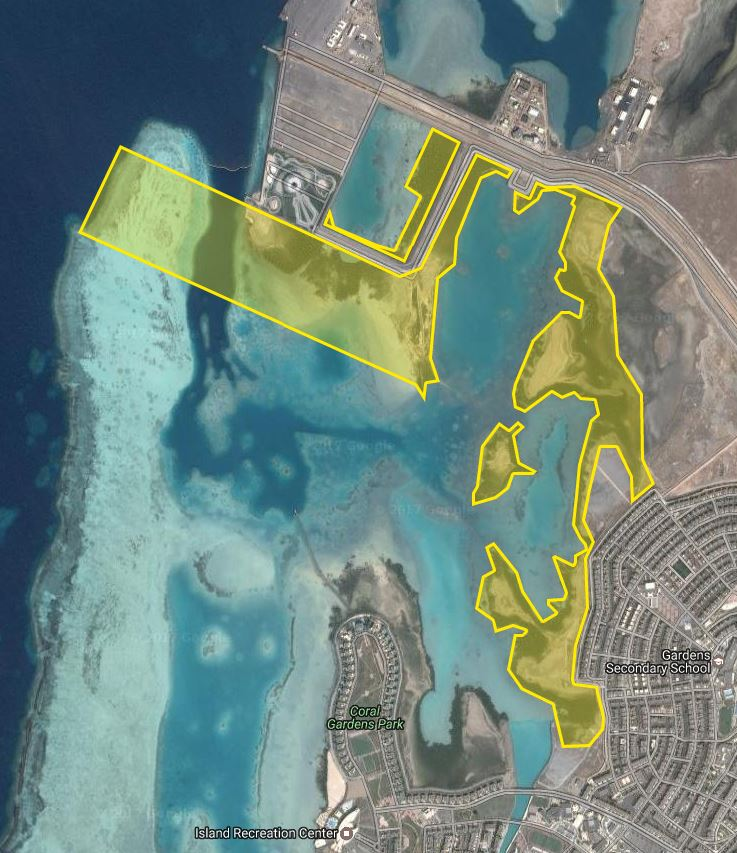
152 hectares of protected area reserved for nature conservation and research
Following a similar strategy of the BMMO network, KAUST also co-chairs the Mangrove Microbiome Initiative (MMI) with the aim of exploring mangrove-associated microorganisms as tools for mangrove preservation and enhancement.
Seagrass meadows are also valuable blue carbon ecosystems and are responsible for 20% of the total organic carbon buried in the ocean. By trapping particles suspended in the water column, seagrasses contribute to sediment stabilization, turbidity reduction, and make the water clearer. Protected from storms and waves and deprived of oxygen, the carbon degrades very slowly, being stored in place for long time scales. In the seagrass meadows of the Red Sea, KAUST researchers study how local seagrasses adapted to live in such harsh conditions of high salinity and high temperatures. This adaptation might help them endure future warming conditions, allowing them to keep their stored carbon in place and away from the atmosphere.
Overall Biodiversity
KAUST Wilderness: A Celebration of Biodiversity, a video created by HSE to publicly showcase KAUST's biodiversity (2017)
Overall, the entire biodiversity of KAUST is a treasure thoroughly protected and celebrated. The Health, Safety, and Environment (HSE) department routinely sets and supervises operational policies, guidelines, and monitoring systems aimed at keeping KAUST ecosystems healthy and thriving.
In fact, thanks to the protection efforts done by KAUST, satellite footage and research data showed an increase in mangrove coverage of 20% from 2005 to 2016, and over 45 percent from 2005 to 2020. The University currently hosts more than 110 hectares of mangroves.
Thanks to both the natural and manmade environment of the university and surrounding community, more than 240 species of resident and migrant birds shelter at KAUST throughout the year. The extensive terrestrial areas also harbor a rich fauna of insects, lizards, snakes, and several native plants and shrubs. In the nearby reefs, dozens of species of fish, coral, crustaceans, and several other invertebrates can be found. The beauty of KAUST's biodiversity, and the need to preserve it, has been showcased to the local and national community in the last years, by featuring it on dedicated websites and by documenting and publishing it in books that are tailored both for older and younger audiences.
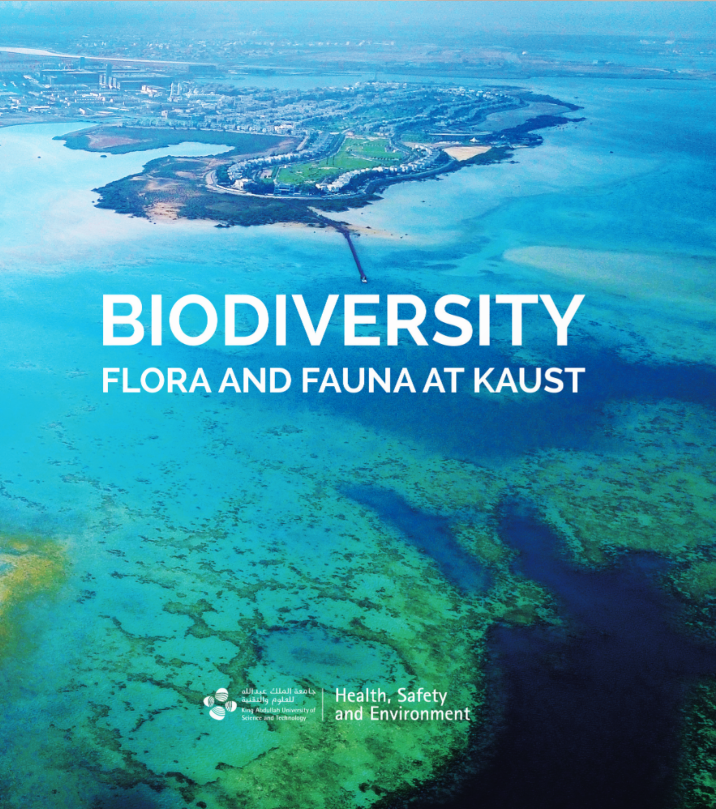
The book "Biodiversity - Flora and Fauna at KAUST" produced by the HSE department and published both in digital and hardcopy versions (2019)
Technologies towards aquatic ecosystem damage prevention
Reports to THE Impact Ranking indicator 14.3.4
KAUST has also been directly involved with industry partners in order to develop strategies and technologies to prevent, mitigate or reverse aquatic ecosystem damage. Given the rising importance of tourism for the Kingdom of Saudi Arabia, the KAUST-TRSDC partnership has deeply focused on spatial planning and technology development to ensure the touristic destination does not damage local ecosystems, but actually enhances them.
One impressive outcome of such collaboration was a pioneering study involving an international team of researchers who, led by KAUST Distinguished Professor Carlos Duarte, used destination-scale marine spatial planning simulations as a sustainable development planning tool to optimize the conservation efforts of the Red Sea project. The results of the study demonstrated that through careful design and planning, coastal development can enhance, rather than jeopardize, conservation.
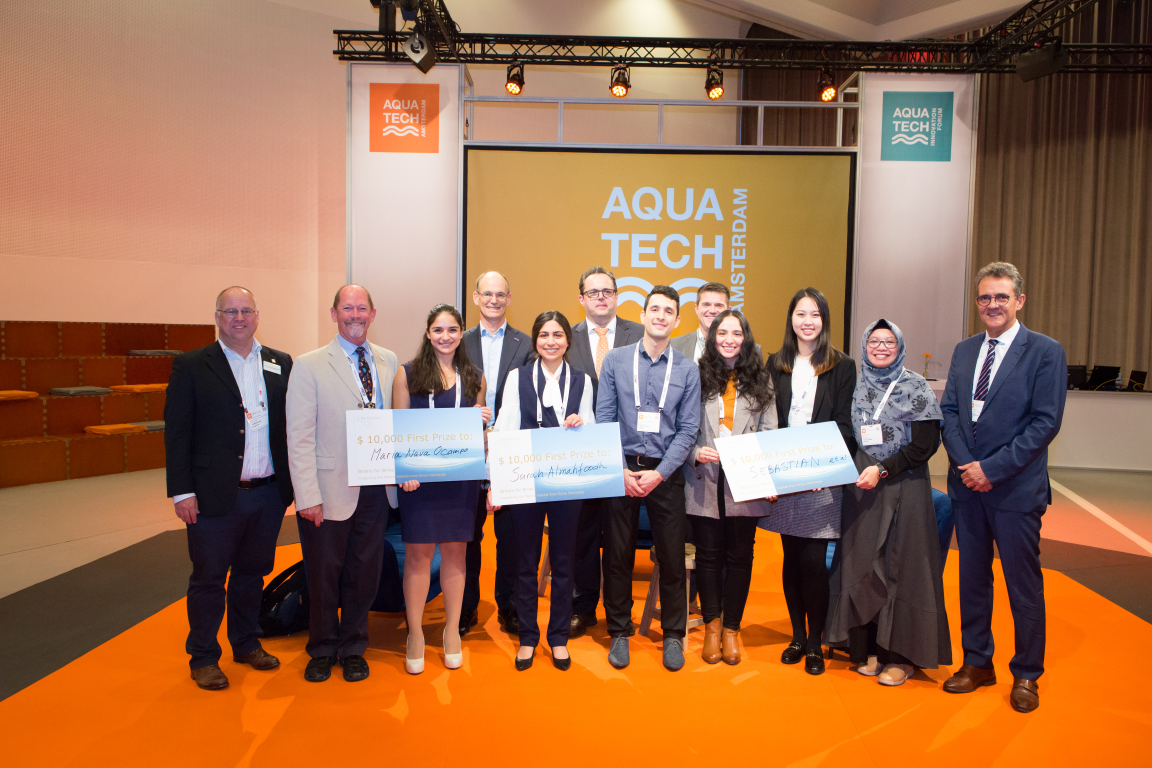
Winners of The Red Sea Development Company’s Brains for Brine Challenge with members of the judging panel during the awards ceremony at Aquatech Amsterdam 2019. Photo by TRSDC
Another fruitful collaboration between KAUST and TRSDC was the competition Brains for Brines. The challenge enticed scientists, engineers, and the overall water industry to propose new solutions to manage the sustainable disposal of brine, the waste product of water desalination.
The competition received over 125 submissions from across the world, and five ideas were selected for final pitching at the Aquatech 2019 event in Amsterdam. Three winning teams, two of which were from KAUST, received cash prizes of 10.000 USD and the chance to pilot their ideas with The Red Sea Development Company.
Water sensitive waste disposal
Water discharge guidelines and standards
Reports to THE Impact Ranking indicator 14.4.1
The Environmental Stewardship policy of KAUST, in place since 2013, ensures that KAUST is committed to (1) protecting the precious marine environment surrounding the University and (2) complying with applicable environmental regulations.
Developed and implemented by the Heath, Safety and Environment (HSE) department, KAUST also possesses an Environmental Risk Management system that is based on an ISO 14001 certified Environmental Management System (EMS). The EMS covers a broad range of the University's operations and activities, ensuring that adverse environmental impacts of these activities are eliminated or minimized, in addition to being compliant with national and international laws.
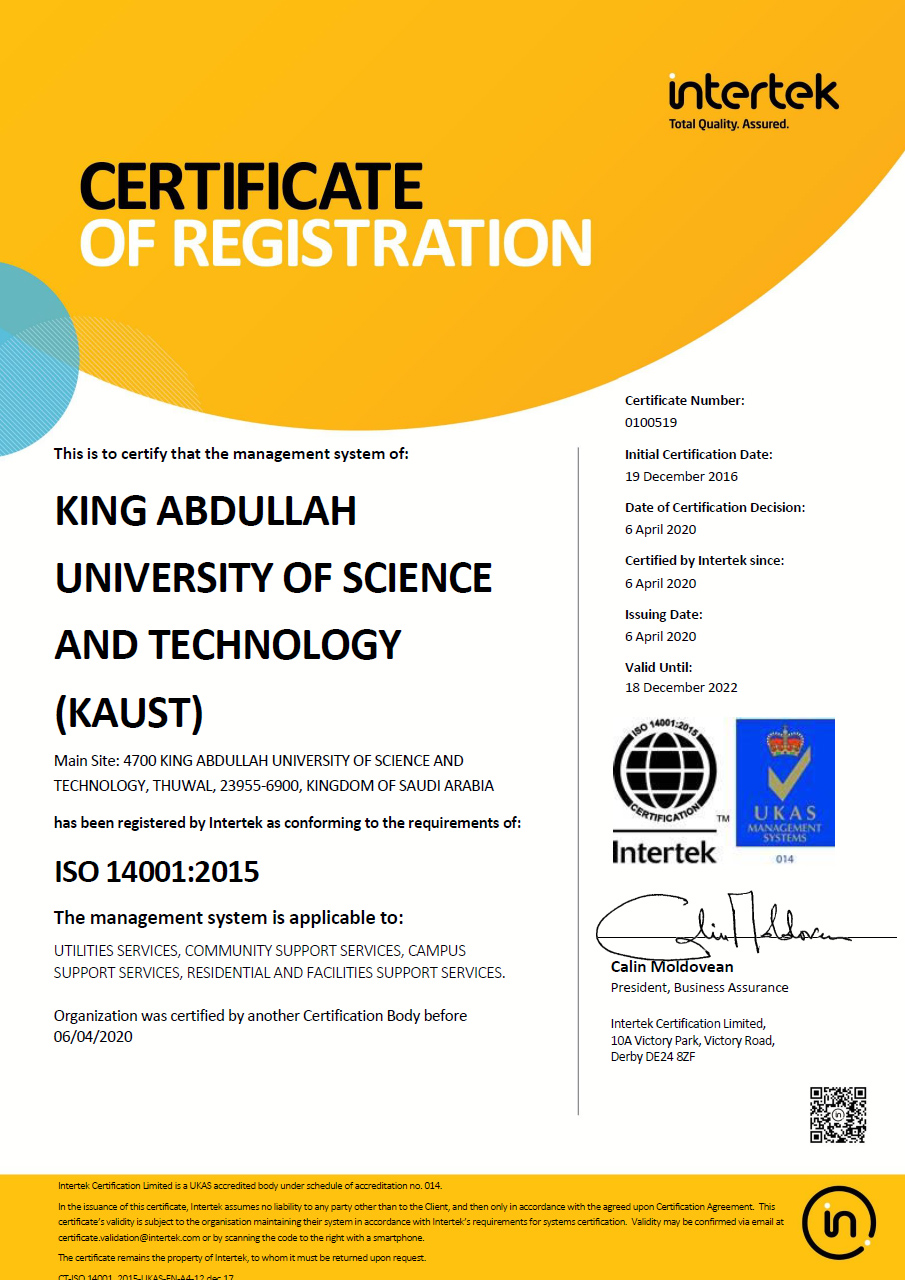
KAUST is ISO 14001:2015 certified for environmental management practices since 2016
Specifically for water discharge, the University has in place a Wastewater Management Procedure. The procedure regulates all discharges that are relevant to KAUST operations based on risk assessment, and include Marine Outfall Management, Direct Discharge, Washing/flushing/testing discharges, Dewatering, Marine Vehicle Sewage, Wastewater Reuse, Septic Tank and F.O.G. Moreover, all wastewater produced at KAUST is collected and treated, and the resulting Treated Sewage Effluents are then used as irrigation water, according to a TSE Water Use Protocol.
Action plan to reduce plastic waste and overall marine pollution
Reports to THE Impact Ranking indicators 14.4.2 & 14.4.3
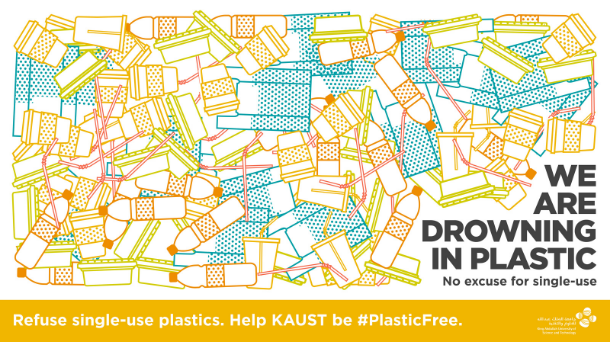
Campaign carried by the Community Life department, to raise awareness about plastic pollution (2020)
In order to tackle the problem of marine pollution, in particular plastic waste, KAUST has been taking steps in order to be a plastic-free campus and community.
In 2020, an action plan has been implemented to gradually reduce plastics from both campus and community retail outlets, and encourage the public to make more environmentally-conscious choices with regards to food packaging. Some of the taken actions include:
- Discounts at selected retailers for bringing your own coffee cup/mug;
- Discontinuing the use of styrofoam boxes as take-away food containers and encouragement of community members to bring their own reusable containers from home;
- Only providing plastic straws in retailers upon express request;
- Phasing-out single-use water bottles by removing them from the campus diner, and several food retailers across campus and the KAUST surrounding community;
- Charging of plastic bags by the local supermarket (postponed by Covid-19-related impacts).
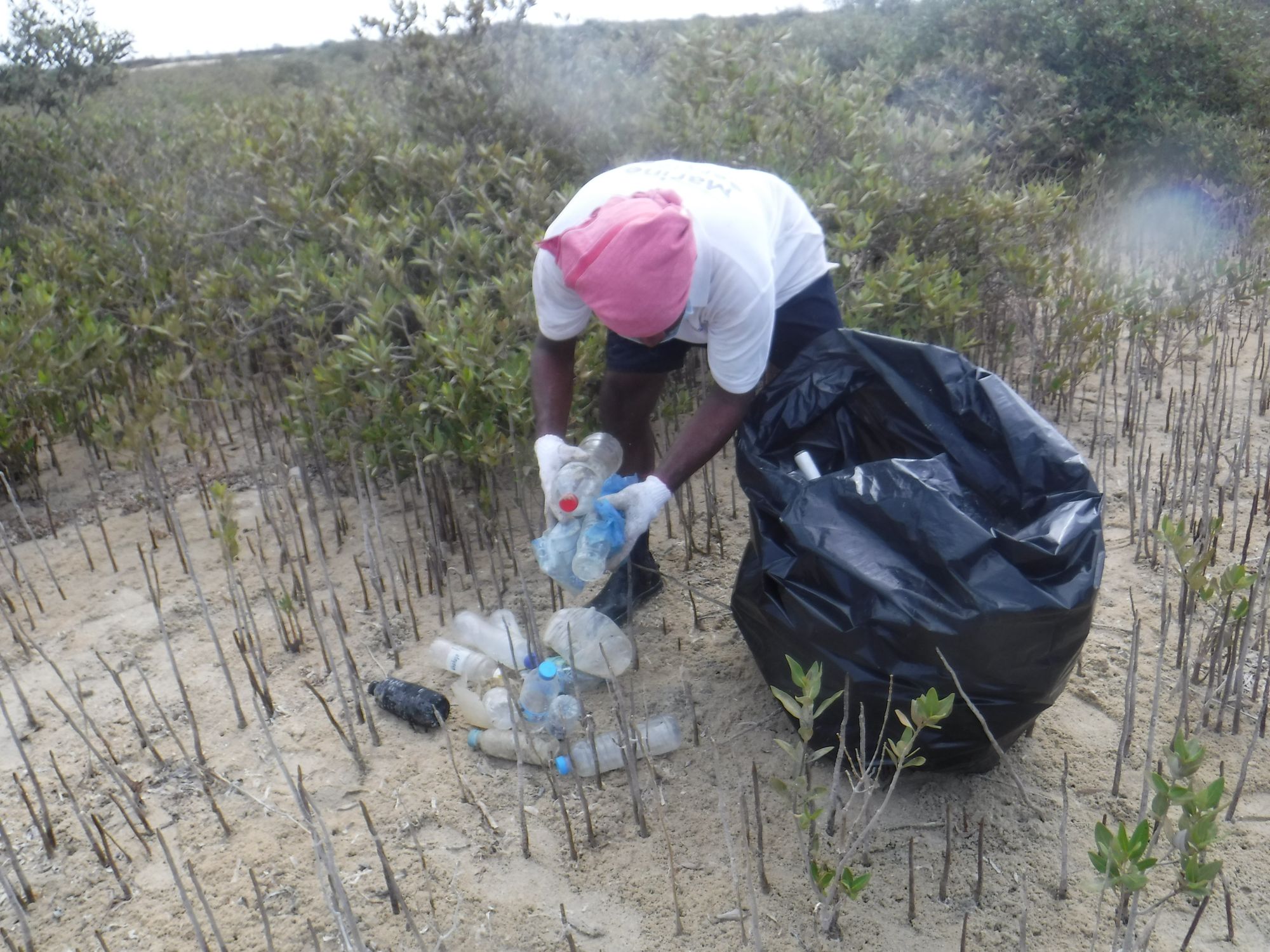
Contractor worker at one of the daily cleaning campaigns at KAUST shores
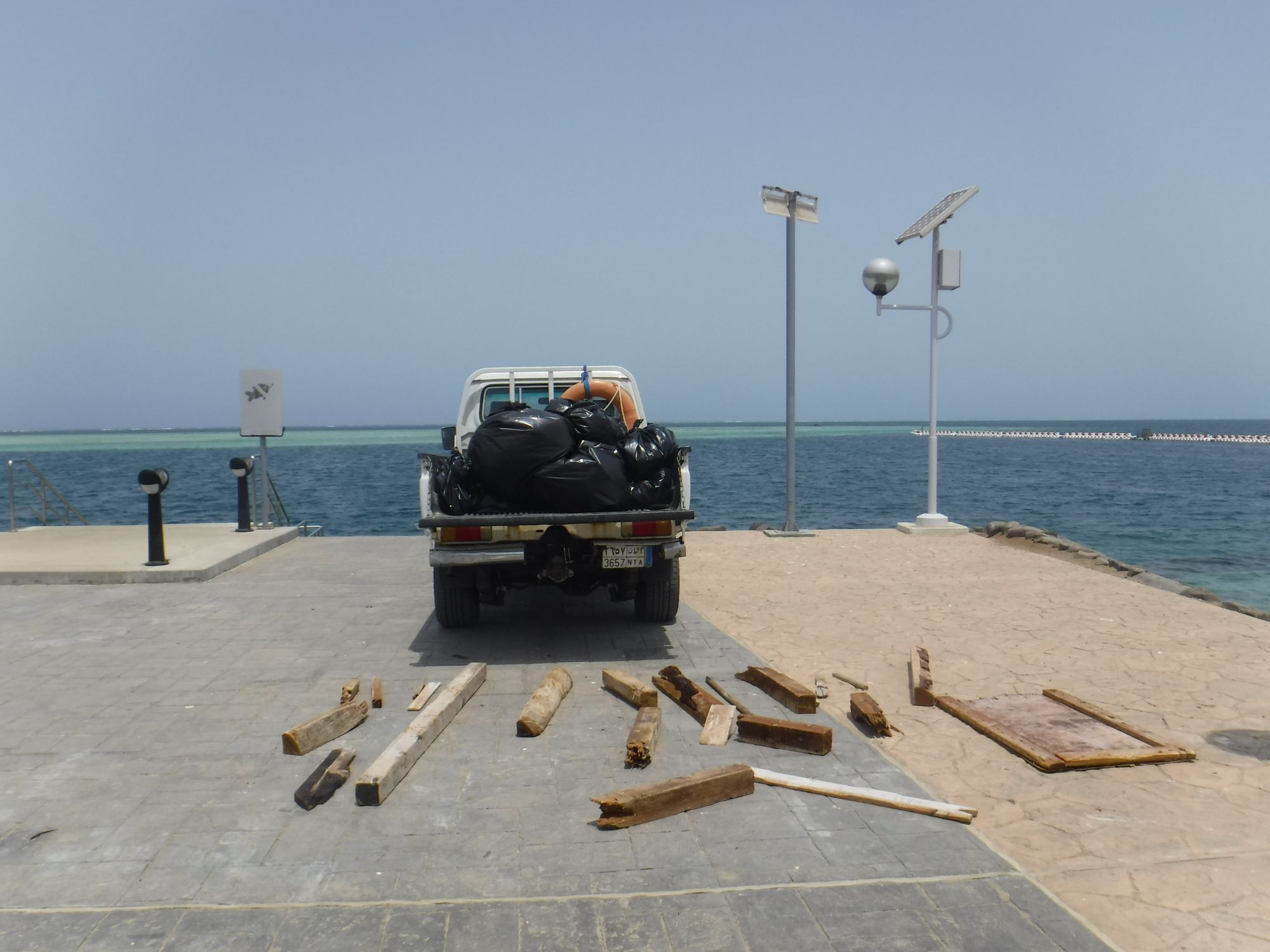
Marine debris collected after a cleaning campaign
Under KAUST's Environmental Stewardship policy, the university is required to minimize any impact its operations have on the surrounding marine environment, which includes any type of pollution.
As one of its strategies, KAUST actively incorporates operational guidelines to reduce marine pollution in agreements and contracts celebrated with external service providers. One example is the contract celebrated between the university and the marine and coastal management contractor Coastline, which ensures that all KAUST shoreline, beaches, and canals are cleaned on a daily basis, in order to prevent agglomeration and disintegration of marine debris.
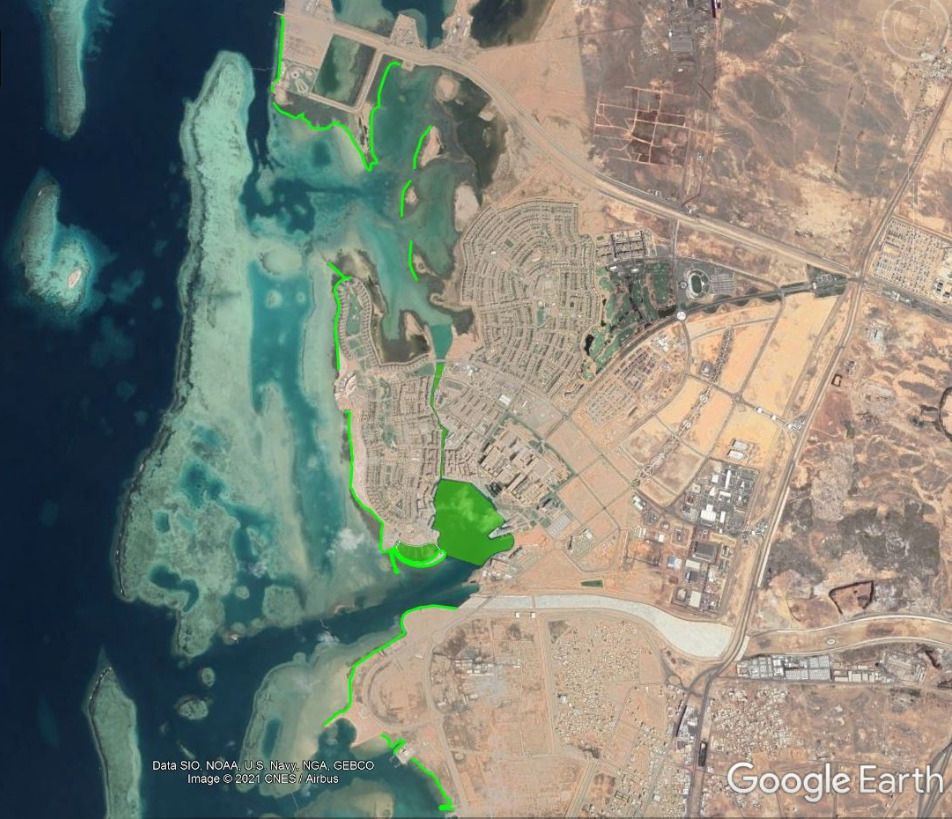
KAUST map highlining (in green) the marine areas routinely cleaned by KAUST contractors, including the Nature Protected Area
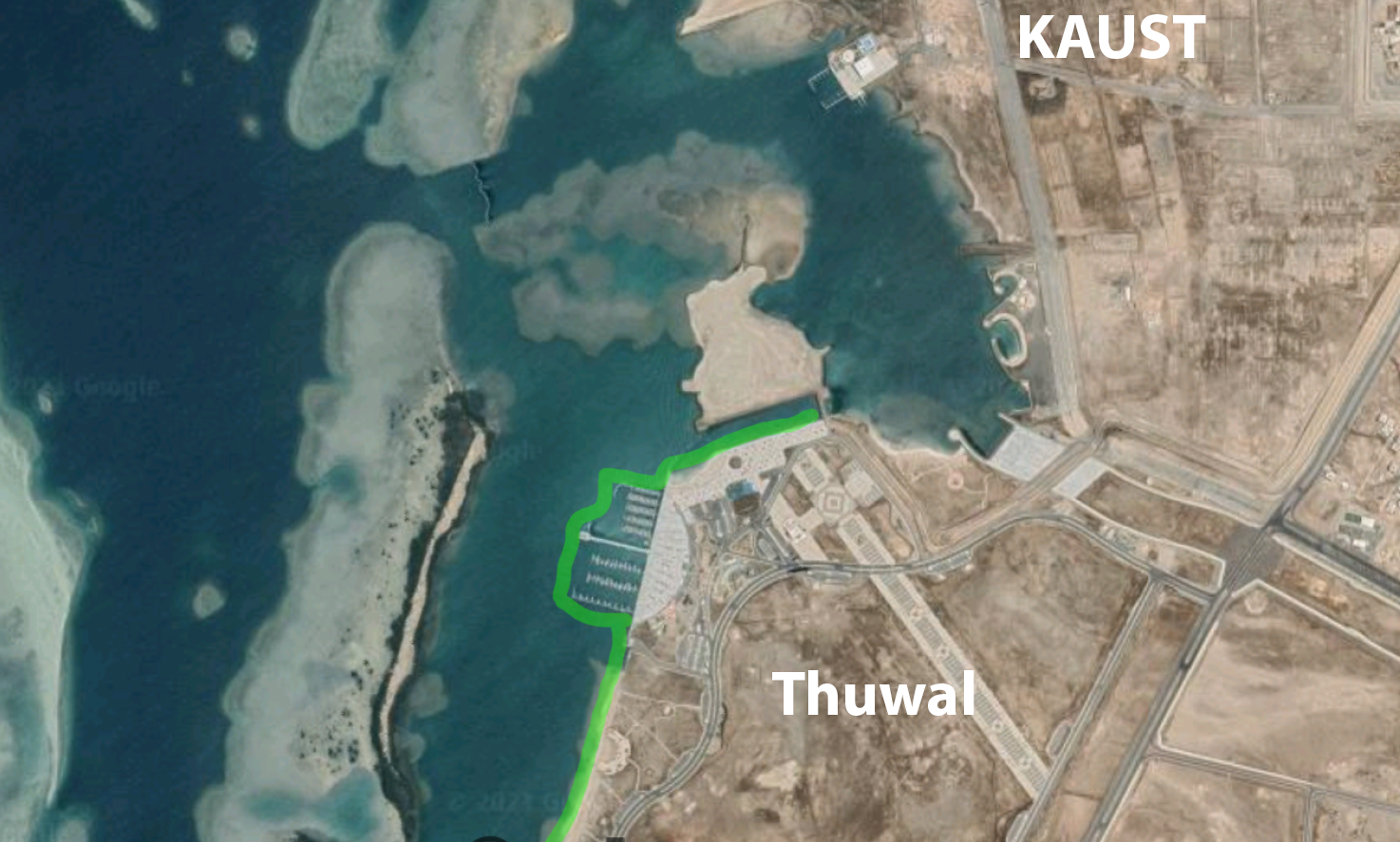
Map highlining (in green) the marine areas in Thuwal cleaned under KAUST sponsorship through its contractors
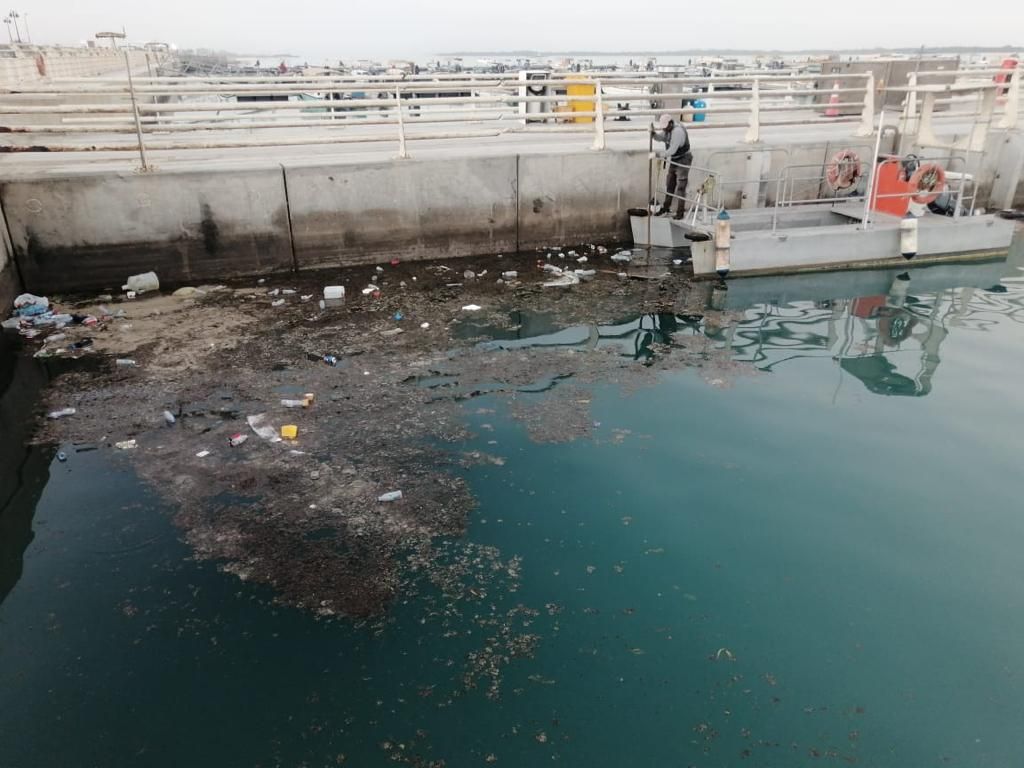
Thuwal shoreline cleaning by KAUST contractor
Coastline has also committed to discontinue the use of single-use plastics in its recreational boat trips and in its restaurants on KAUST grounds. Finally, under the same contract agreement, Coastline is also mandated to clean the shores of KAUST neighboring village, Thuwal. All areas at Thuwal's fisherman marina, marina harbor, marina corniche, and beach shoreline are routinely cleaned by workers and buddy water boats, in order to ensure the least amount of debris and pollution reach the sea within and around KAUST.
Maintaining a local ecosystem
Minimizing the alteration of aquatic ecosystems through monitoring
Reports to THE Impact Ranking indicator 14.5.1 & 14.5.2
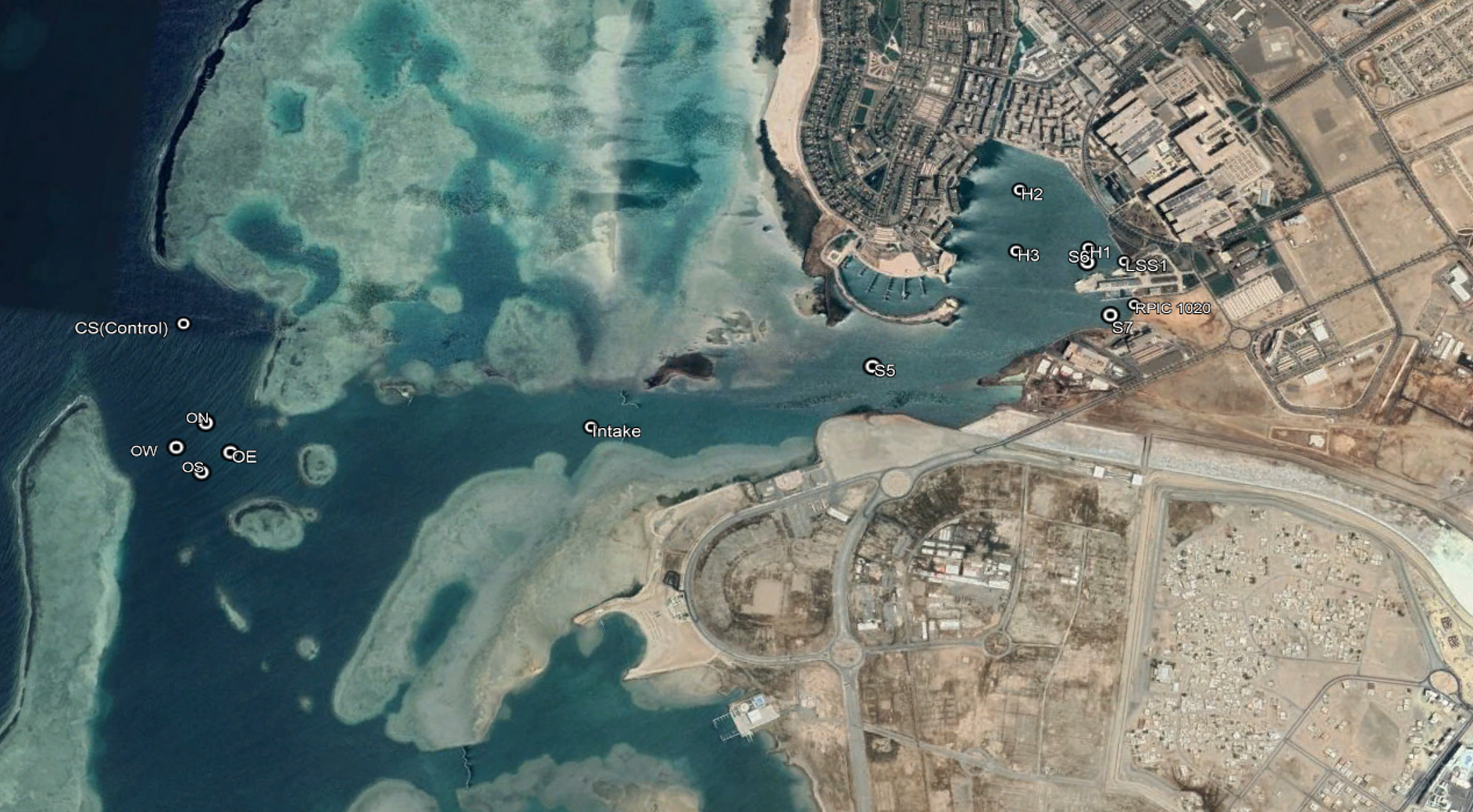
Sampling points at several locations at KAUST shore, as part of the annual ambient water monitoring program carried by the HSE department
KAUST routinely evaluates the impact of its operations on its surrounding marine environment. To do so, monitoring of marine ambient water quality around KAUST is carried out bi-annually, to ensure all discharged water does not affect local aquatic ecosystems. The water samples are taken at several locations both on-shore, near-shore, and off-shore, and submitted to an accredited independent laboratory for analysis, being the results communicated and evaluated by the Health, Safety and Environment (HSE) department.
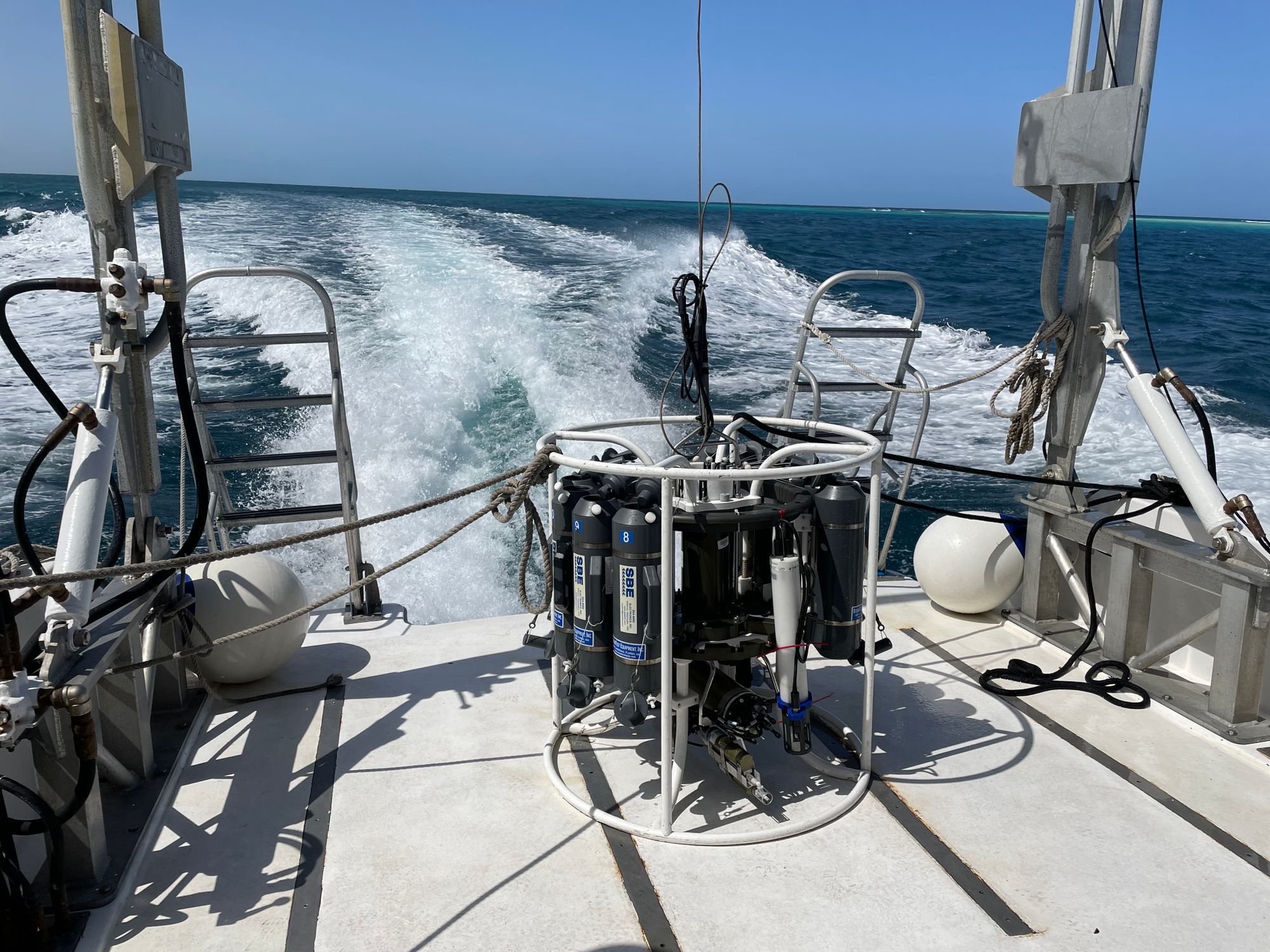
Sample collection apparatus prepared to be released for ambient water collection at one of the monitoring surveys (2020)
HSE also supervises and ensures the Wastewater Management Procedure is followed, especially by marine research infrastructures such as the Coastal and Marine Resources Core Lab. Additionally, another mechanism to protect the health of the aquatic system is to make sure that any recreational boats discharge grey wastewater in compliance with The International Convention for the Prevention of Pollution from Ships (MARPOL).
HSE also monitors the water quality of manmade water bodies in the community surrounding KAUST. One example is the controlling and monitoring of the golf lake discharge that goes into marine areas. The Golf Course Lake System is monitored quarterly from multiple depths and water samples are submitted to an accredited independent laboratory for chemical, physical, and physico-chemical analysis. Approval is then sought from KAUST HSE prior to discharge, being contingent on water quality complying with the marine discharge water guidelines (set in the Wastewater Management Procedure), and that the flow volume is recorded.
Programs & collaborations towards good aquatic stewardship practices
Reports to THE Impact Ranking indicators 14.5.3 & 14.5.4
The deeply ingrained Environmental Stewardship policy of the university serves as a catalyst for KAUST students, faculty and researchers to develop and participate in programs, initiatives, and collaborations focusing on stewardship practices and environmental protection.
One example is KAUST's partnership with the outreach scientific journal Frontiers for Young Minds. Young Minds is a scientific journal that is edited for, and reviewed by, children. The KAUST Collection "An Alien place on Earth: The Red Sea as a model for Future Oceans", still ongoing, exposes children from around the world to recent marine research carried in the Red Sea, and how that knowledge might help to protect marine life worldwide, with a fun and age-appropriate language.
KAUST graduate student, creator of the Frontiers for Young Minds KAUST Collection, talking about the program at the TEDx KAUST-Driving Force (2019)
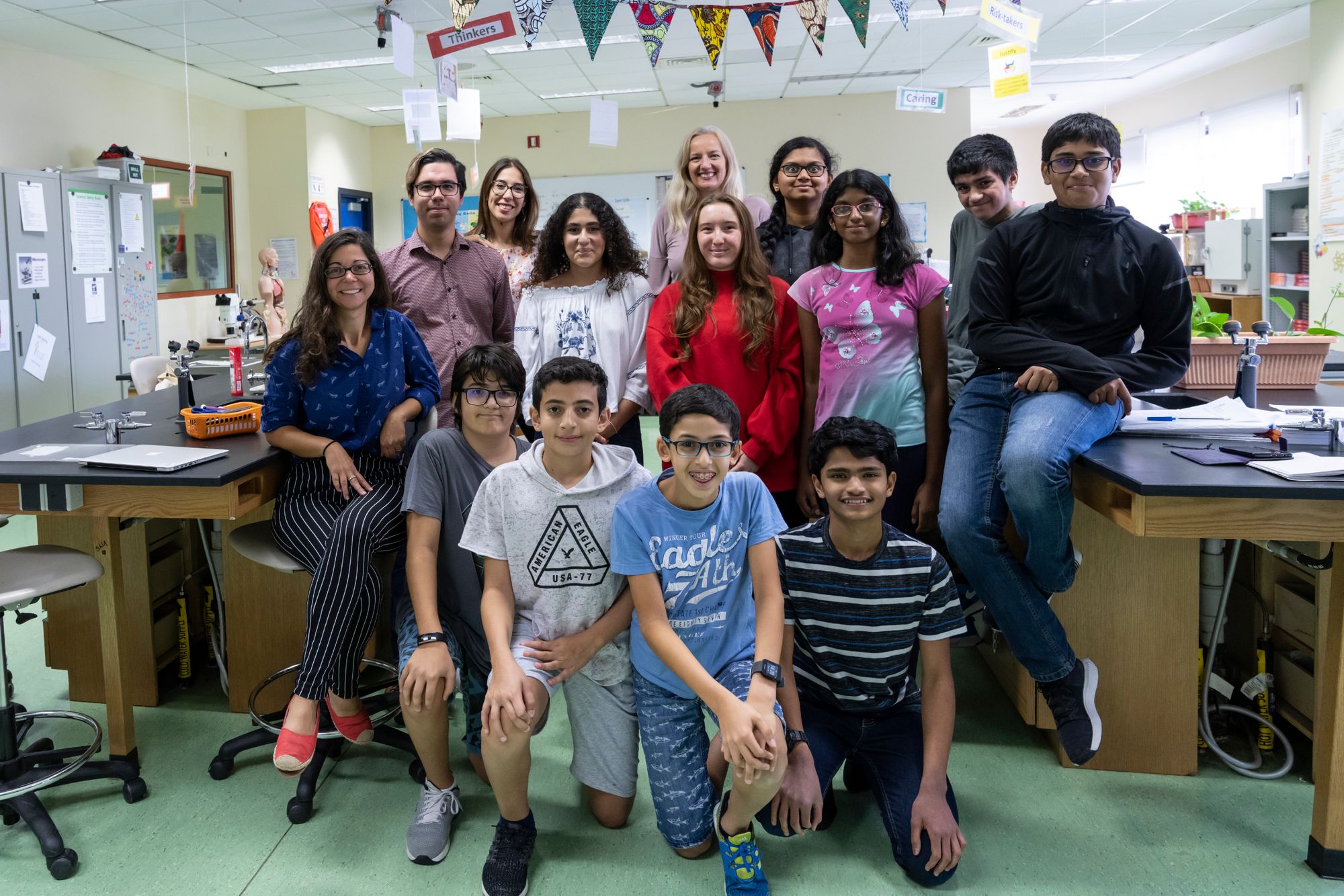
TKS students and KAUST graduate students at one of the review sessions carried at the school, under the supervision and guidance of TKS science teachers (2019)
Created and co-edited by a KAUST graduate student and faculty, the collection acts as a cross-cutting collaboration by involving 36 faculty, researchers, pos-docs and Ph.D. students from the university (and some international collaborators), and 38 school students and teachers from The KAUST School and the local Thuwal high schools (as part of SNA’s Young Learners Development Program (YLDP)). The review sessions are carried out in person, giving school students the opportunity to learn about advanced marine research topics directly from scientists.
Currently, the Collection counts 12 published articles and more than 95,000 global views, and counting. It also was marked by a series of "firsts", being the first Collection in the journal about the ocean, the first Saudi contribution to the journal, the first article Collection from the Middle East, and the first Saudi public school participation.
KAUST Sci-Café on Extreme Marine Environments (2019), which explored the peculiarities of the Red Sea. The Sci-Café is a live-streamed, community-open discussion forum where KAUST faculty are invited to talk about their expertise on key development subjects and foster healthy discussions between all members of the community
Another ongoing program is the KAUST Sci Café, a public discussion forum that allows for a deep engagement between live and online public, and KAUST faculty and researchers. As part of the Sci-Café open discussions, the topic of aquatic stewardship, particularly for the Red Sea, is routinely addressed in any session discussing aquatic ecosystems.
Moreover, the program has been adapted to the local school as the "Sci-Café TKS". Under a similar panel discussion format, the school version includes graduate students as panelists and interactive activities to engage younger audiences. The topics of marine conservation and marine plastic pollution were addressed at the launch of the ongoing program.
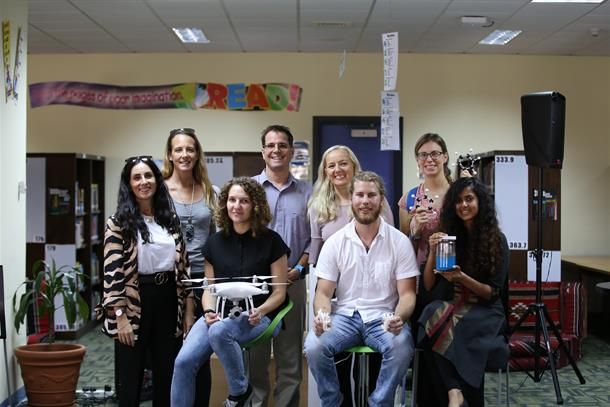
Panelists and organizers of the Marine Pollution & Plastic session of the "Sci-Café TKS", which marked the launch of the program (2019). Photo: R. Lennon
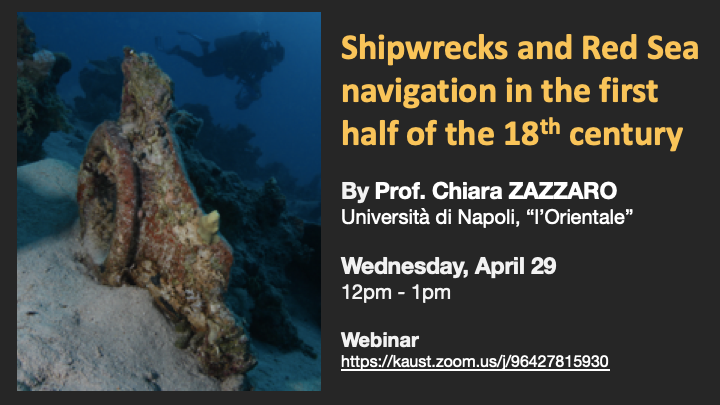
Announcement of one of the webinars under the Cultural Heritage Event series (2020)
KAUST also organized ad-hoc events and initiatives that exposed the community to the heritage, cultural, and social importance that the Red Sea carries to the Kingdom. Through the Cultural Heritage Event series, topics such as the ethnography and memories of coastal communities and the archeological history of shipwrecks in the Red Sea were presented to KAUST's academic and local community by national and international experts, with the aim of sparking an appreciation for the Red Sea and its unique history.